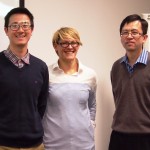This blog is part of the Thinking Systems series, and has been published early as it is relevant to a presentation Graham is making as part of the SMART Seminar Series. For more information, view the seminar flyer online. Continue reading
Author Archives: Jessica Symonds
A heuristic combinatorial optimisation approach to synthesising a population for agent based modelling purposes
 By Nam Huynh
By Nam Huynh
Micro-simulations, such as epidemiology models or activity-based models for urban transport demanding forecasting purposes, usually involve a large number of agents representing the real population living in the area being studied. It is however extremely expensive, if not impossible (due to stringent privacy laws in certain countries), to carry out a survey that obtains a fully disaggregated data set to describe the demographics and characteristics of the agents of interest. Continue reading
Dealing with ecosystems IV: Hope in constraints?
This blog is continued from Thinking Systems #10
In the last three blogs we saw that management and restoration of the entities we call ecosystems is problematic and driven by assumptions, myths and values. This is particularly so at the level of species and populations. Conservation biology and restoration ecology have had their local successes, but overall, the response to major initiatives has been poor. Global biodiversity continues to decline and, while there are strong calls to restore landscapes, going back to a prior state seems very difficult. Continue reading
Big data platform for mining user-generated content (UGC)
I am currently undertaking a study which uses an innovative cloud-computing tool – developed here at SMART Infrastructure Facility – to collect, analyse, and visualise data from different social media networks in Australia, China and Korea. Specifically, it aims to investigate how different countries are using social media platforms respectively to contribute to topical conversations on culture and politics. By gathering, sorting, and displaying information from millions of data records on various topics such as films and TV dramas, this project will increase public awareness among three different countries. Continue reading
How resilient are our infrastructure systems?
Natural hazards have the potential to cause large scale impacts and disruption to all countries and if these events occur in highly populated areas the impacts can be catastrophic. The severity and lasting impact of these hazards are often linked to the resilience of critical infrastructure systems (including: water distribution networks, electrical systems and transportation networks) which underpin our communities and support social and economic development. Continue reading
Mining a System: The Use of Data Mining and System Dynamics to Explore Technology Integration
 By Jack (Jie) Yang, Jun Ma & Sarah Howard
By Jack (Jie) Yang, Jun Ma & Sarah Howard
Technological innovation in schools has, as yet, resulted in relatively limited teacher and student engagement with new ways of learning supported through information and communication technologies (ICTs). One of the possible reasons for this is that educational research has struggled to grasp the complexity or dynamic nature of technology integration. Data mining techniques have drawn the attention of researchers from the education research area to understand some of the complexity of technology integration within a theoretical system model of technology integration. Continue reading
Potential disaster or golden opportunity?
 Development around road interchanges can be a double-edged sword where controlled growth brings dividends, while uncontrolled growth creates headaches for motorists, land owners and local officials. Continue reading
Development around road interchanges can be a double-edged sword where controlled growth brings dividends, while uncontrolled growth creates headaches for motorists, land owners and local officials. Continue reading
Dealing with ecosystems III: Causal thickets and changing correlations
This blog is continued from Thinking Systems #9
This is a good place to stop for a while and read William Wimsatt’s (2007) book Re-engineering philosophy for limited beings: piecewise approximations to reality. Wimsatt’s goal in writing that book was to provide a guide to bounded rationalism and heuristics for a messy world. The book draws on a wide range of sources including Andreas Wagner and one of my favourite books, Daniel Dennett’s (1995) “Darwin’s dangerous idea: evolution and the meanings of life. Dennett pointed out anyone that takes a consequentialist view whilst living in the middle of a system can only ever have partial knowledge. Continue reading
Dealing with ecosystems II: The field of myths and dreams
This blog is continued from Thinking Systems #8
At present, working either with a restricted set of values or when we claim to be totally value free (impossible in practice), we plan remediation programmes as “predict-act” schemes and then fail to deliver the goods. It’s very much like the myth of the field of dreams: “build it and they will come…” but often they don’t! [Remember the important roles of chance, necessity and 2nd order interactions.] Continue reading
Development and comparison of two interaction indices between extractive activity and groundwater resources
Groundwater and rock are intensively exploited in the world. Given the population density and environmental pressures, quarry lateral extension may be limited. Hence the only solution for the rock operators is to excavate deeper as long as the deposit structure makes it possible. Consequently the water table of the geological formation exploited might be reached when the quarry is deepened. A dewatering system is therefore installed so the quarry activities can continue, possibly impacting the nearby water catchments. Continue reading




